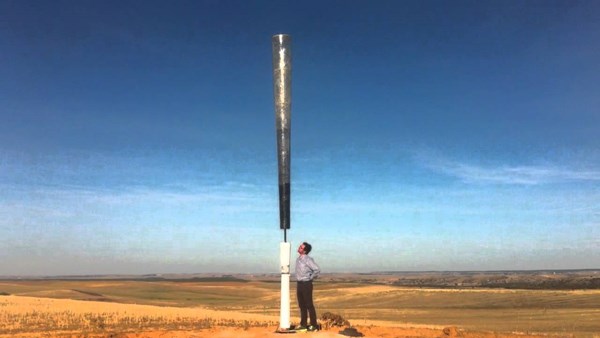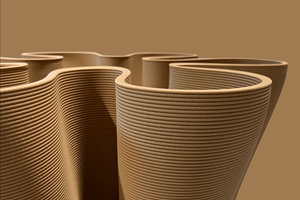Wind energy: No blades needed?
A startup seeks to take the blades out of wind generators.

Vortex Bladeless (Boston, MA, US) believes that wind energy could use an extreme makeover. Instead of capturing energy via the rotational motion of a turbine, the company has developed a wind generator, called the Vortex, which is a carbon-fiber intensive wind generator without blades. The Vortex takes advantage of what’s known as vorticity, an aerodynamic effect that occurs when wind breaks against a solid structure. The Vortex structure starts to oscillate, and captures the energy that is produced.
The company claims it hasn’t simply just removed the blades, but rather designed it to have no parts in contact at all. (So no gears, linkages, etc.).
Vortex integrates the tower and generator into one structure, requiring less moving parts and less material to produce the same amount of electricity. It also eliminates the nacelle, the support mechanisms and the blades. As cost is a big driver for just about everything, Vortex Bladeless touts that manufacturing savings are roughly estimated at around 53% of the usual wind turbine production cost. And the company claims that the Vortex will produce energy at a 40% lower cost than a comparable wind installation.
Vortex has five main parts: the foundation, rod, generation system, tuning system and mast. The carbon fiber rod gives strength and flexibility to the movement, while minimizing energy dissipation. And the mast is a light circular structure made of fiberglass and carbon fiber. The mast acts a wind breaker that generates the oscillatory movement thanks to what the company calls the ‘Vortex Shedding’ effect.

Company officials do caution that the Vortex is not immune to fatigue. The wind can cause twisting and displacement of the structure, primarily in the elastic rod and especially in the lower section that has to withstand greater forces. However, studies carried out by Vortex Bladeless reportedly confirm that the stress on the rod is far from the working limit of the materials. Computational modeling estimates operational lifetime of the installation to be between 32 and 96 years.
Vortex Bladeless has finalized wind tunnel tests, most of the R&D is done and they have a working prototype. The company also has multiple patents of its technology. Execs also have launched a crowdfunding campaign that will help it create the commercial pilot for its first product, Vortex Atlantis (100 W).
While the technology is quite inventive, bringing such a radical new product to the wind energy field is not an easy feat.
For instance, a recent article in the MIT Technology Review took a critical eye to the technology.
“If you have a common propeller-type wind turbine, you have a big area swept by the blades,” says Martin Hansen, a wind energy specialist at the Technical University of Denmark. “Here you just have a pole.”
In addition to capturing less energy, oscillating cylinders can’t convert as much of that energy into electricity, Hansen says. A conventional wind turbine typically converts 80 to 90% of the kinetic energy of its spinning rotor into electricity. David Yáñez says his company’s custom-built linear generator will have a conversion efficiency of 70%.
Is this bladeless wind generator too good to be true? Or will it become the new normal?
Related Content
Otto Aviation launches Phantom 3500 business jet with all-composite airframe from Leonardo
Promising 60% less fuel burn and 90% less emissions using SAF, the super-laminar flow design with windowless fuselage will be built using RTM in Florida facility with certification slated for 2030.
Read MoreWelding is not bonding
Discussion of the issues in our understanding of thermoplastic composite welded structures and certification of the latest materials and welding technologies for future airframes.
Read MoreRevisiting the OceanGate Titan disaster
A year has passed since the tragic loss of the Titan submersible that claimed the lives of five people. What lessons have been learned from the disaster?
Read MoreSulapac introduces Sulapac Flow 1.7 to replace PLA, ABS and PP in FDM, FGF
Available as filament and granules for extrusion, new wood composite matches properties yet is compostable, eliminates microplastics and reduces carbon footprint.
Read MoreRead Next
Ultrasonic welding for in-space manufacturing of CFRTP
Agile Ultrasonics and NASA trial robotic-compatible carbon fiber-reinforced thermoplastic ultrasonic welding technology for space structures.
Read MoreNext-gen fan blades: Hybrid twin RTM, printed sensors, laser shock disassembly
MORPHO project demonstrates blade with 20% faster RTM cure cycle, uses AI-based monitoring for improved maintenance/life cycle management and proves laser shock disassembly for recycling.
Read MoreScaling up, optimizing the flax fiber composite camper
Greenlander’s Sherpa RV cab, which is largely constructed from flax fiber/bio-epoxy sandwich panels, nears commercial production readiness and next-generation scale-up.
Read More












